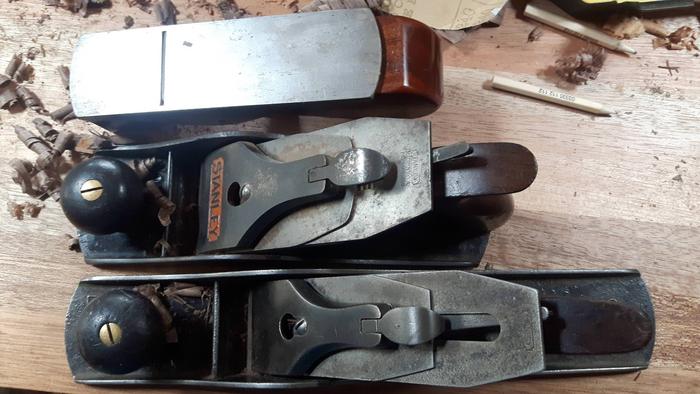phil.p":3th9tc14 said:
A block plane is far from the best plane for a starter - you'd do much better with a 4, 4 1/2, 5, or 5 1/2. I (personally) would say without doubt a 5 1/2 as it is probably the most versatile
+1
Unless trimming laminates is all you do then a block plane is a poor choice for your one and only plane. A competent woodworker can do everything, including end grain work, with virtually any bench plane. However, when you're first starting out some bench planes are easier to use than others.
A number four is often recommended for beginners, but an 04 or an 04 1/2 both have the blade set very close to the front. Here's a photo showing an 04 on top of an 05 to illustrate the point,
Many beginners find it difficult to
start the planing cut, and consequently they massacre the first inch of the workpiece. They would do better with a slightly longer plane, one that has more of the sole resting on the workpiece before the cut commences. When traditional woodworking was widely taught in schools, the single bench plane they virtually all used was the 05. That
length of bench plane is simply the best all rounder.
An 05 was the preferred choice for 11-16 year olds. But if you're physically stronger then a better choice would be the slightly
wider 05 1/2 that Phil recommended. If you don't have the hand and arm strength then stick with an 05. Don't sweat it though, it's not a huge deal either way.
An older Record or Stanley 05 or 05 1/2 would make an excellent choice. However, there's no dodging the fact that some of them may need a bit of work to perform efficiently. If you don't feel equal to that, and if you have deep pockets, then a Lie Nielsen or Veritas would perform superbly straight from the box. Alternatively some far eastern brands offer nearly all the advantages of a Lie Nielsen but at a much keener price, brands like this,
https://woodworkersworkshop.co.uk/produ ... k-plane-v3
Nothing in woodworking is ever that simple though. Because if you do decide to go for one of these planes, then you have to be aware that Record and Stanley have thinner blades ("irons"), but the others have much thicker blades.
I've used both and they both work well, however a thicker blade is much, much harder to keep sharp. I won't bore you with the geometry of it all, but over time you'll need to remove far more metal with a thicker blade than a thinner Record or Stanley version. So much so that IMO modern thicker blades just aren't practical unless you have some kind of power assisted method for grinding. If you try to do the job purely by hand, even with a coarse diamond stone, then you'll be looking at over a hundred tedious strokes on the stone
every time you sharpen. If you have a camber on your blade (as you should) then you have to repeat all those strokes at different points around the blade to maintain the camber's shape. Trust me, that will take the fun out of woodworking in pretty short order!
One final point. When you get your plane invest the time to learn to use it properly. Lots of hobbyist woodworkers think they're competent with a bench plane, but in truth not many of them actually are. A good test of planing skill is if you can bring a rough sawn board to square and true on all six sides, and if you can edge joint two boards for an invisible glue line. It's worth putting in the effort to get to this level, besides being immensely satisfying those two skills will open the door to a vast range of projects.
Good luck!





































